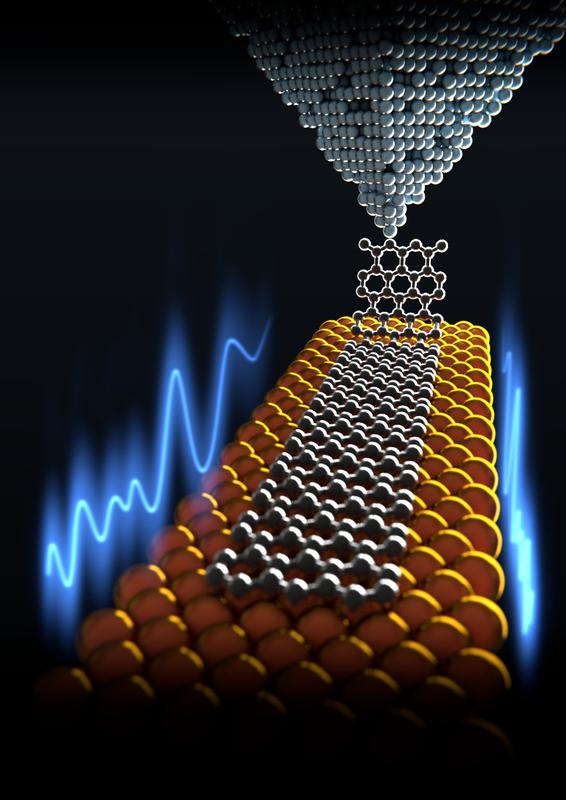Graphene Slides Smoothly Across Gold

A graphen nanoribbon was anchored at the tip of a atomic force microscope and dragged over a gold surface. The observed friction force was extremely low. University of Basel, Department of Physics
In future, graphene could be used as an extremely thin coating, resulting in almost zero energy loss between mechanical parts. This is based on the exceptionally high lubricity – or so-called superlubricity – of modified carbon in the form of graphene. Applying this property to mechanical and electromechanical devices would not only improve energy efficiency but also considerably extend the service life of the equipment.
Fathoming out the causes of the lubricant behavior
An international community of physicists have studied the above-average lubricity of graphene using a two-pronged approach combining experimentation and computation. To do this, they anchored two-dimensional strips of carbon atoms – so-called graphene nanoribbons – to a sharp tip and dragged them across a gold surface.
Computer-based calculations were used to investigate the interactions between the surfaces as they moved across one another. Using this approach, the research team led by Prof. Ernst Meyer at the University of Basel is hoping to fathom out the causes of superlubricity; until now, little research has been carried out in this area.
By studying the graphene ribbons, the researchers hope to learn about more than just the slip behavior. Measuring the mechanical properties of the carbon-based material also makes sense because it offers excellent potential for a whole range of applications in the field of coatings and micromechanical switches. In future, even electronic switches could be replaced by nanomechanical switches, which would use less energy for switching on and off than conventional transistors.
The experiments revealed almost perfect, frictionless movement. It is possible to move graphene ribbons with a length of 5 to 50 nanometers using extremely small forces (2 to 200 piconewtons). There is a high degree of consistency between the experimental observations and the computer simulation.
A discrepancy between the model and reality appears only at greater distances (five nanometers or more) between the measuring tip and the gold surface. This is probably because the edges of the graphene nanoribbons are saturated with hydrogen, which was not accounted for in the simulations.
“Our results help us to better understand the manipulation of chemicals at the nano level and pave the way for creating frictionless coatings,” write the researchers.
Researchers from the Empa were involved in the project as well.
Original source
Shigeki Kawai, Andrea Benassi, Enrico Gnecco, Hajo Söde, Rémy Pawlak, Xinliang Feng, Klaus Müllen, Daniele Passerone, Carlo A. Pignedoli, Pascal Ruffieux, Roman Fasel and Ernst Meyer
Superlubricity of Graphene Nanoribbons on Gold Surfaces
Science (2016), doi: 10.1126/science.aad3569
Further information
Prof. Ernst Meyer, University of Basel, Department of Physics, tel. +41 61 267 37 24, email: ernst.meyer@unibas.ch
https://www.unibas.ch//en/News-Events/News/Uni-Research/Graphene-Slides-Smoothly…
Media Contact
All latest news from the category: Physics and Astronomy
This area deals with the fundamental laws and building blocks of nature and how they interact, the properties and the behavior of matter, and research into space and time and their structures.
innovations-report provides in-depth reports and articles on subjects such as astrophysics, laser technologies, nuclear, quantum, particle and solid-state physics, nanotechnologies, planetary research and findings (Mars, Venus) and developments related to the Hubble Telescope.
Newest articles

Superradiant atoms could push the boundaries of how precisely time can be measured
Superradiant atoms can help us measure time more precisely than ever. In a new study, researchers from the University of Copenhagen present a new method for measuring the time interval,…

Ion thermoelectric conversion devices for near room temperature
The electrode sheet of the thermoelectric device consists of ionic hydrogel, which is sandwiched between the electrodes to form, and the Prussian blue on the electrode undergoes a redox reaction…

Zap Energy achieves 37-million-degree temperatures in a compact device
New publication reports record electron temperatures for a small-scale, sheared-flow-stabilized Z-pinch fusion device. In the nine decades since humans first produced fusion reactions, only a few fusion technologies have demonstrated…





















